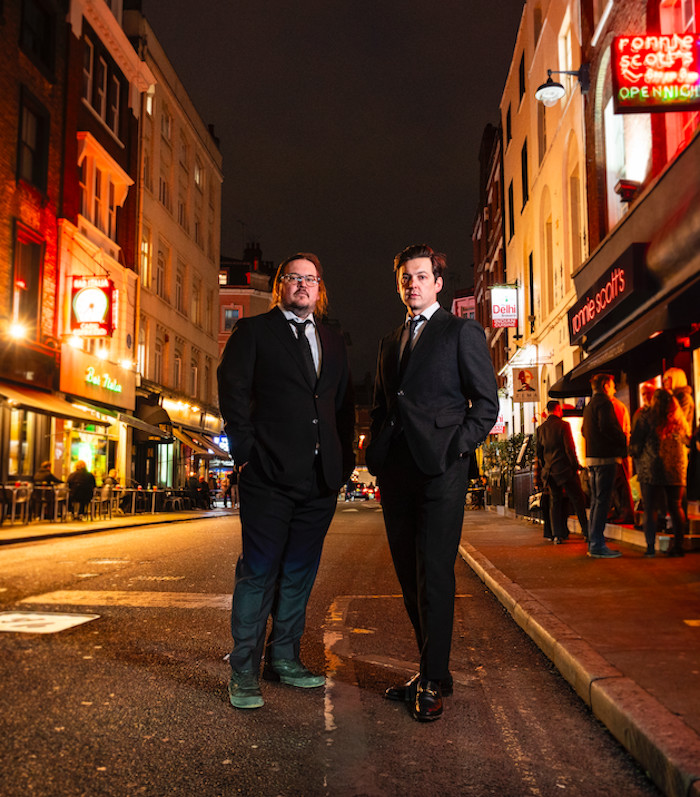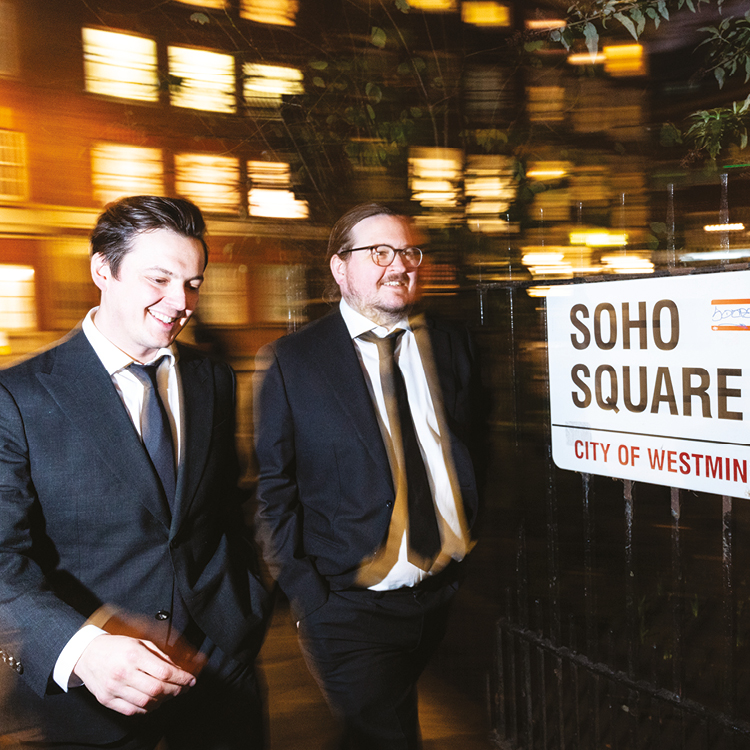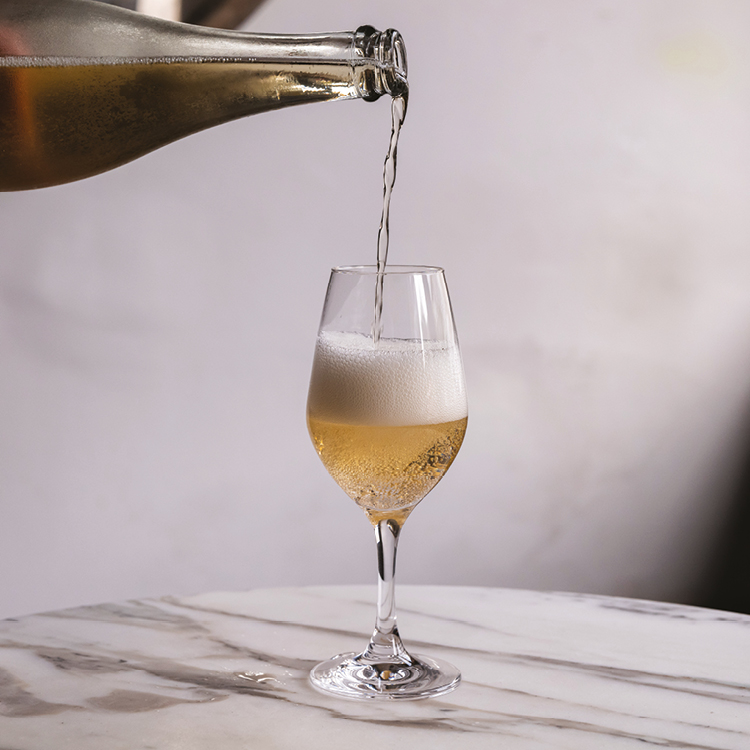
Brothers Max and Noel Venning are taking their established-in-Dalston Three Sheets name to a second London site, in Soho. Hamish Smith finds out what to expect from the entrepreneurial duo.
It’s the summer of 2016 and Max Venning is readying his station at his new bar. There’s been little fanfare – in fact, the space has barely been refurbished from its days as a coffee shop. But Max’s knocked around hospitality long enough to know how to get the fundamentals right. He’s given the place a clean and a lick of paint, hung some pendant lighting, put some tealights on the tables and scribbled down a menu of five drinks.
“What’s the place called?” asks the bar’s first customer, wandering in off Kingsland Road. “Oh, I don’t even know,” replies Max. It’s Friday and he only got the keys on Wednesday – he’d need a few more days to settle on the name.
Temporarily at least, the bar would become Between the Sheets. Not until the site had been properly refurbished and brother Noel had worked his notice and made it down from Manchester would it take on its proper name. Three Sheets was the realisation of a concept they’d had in readiness for six months, should a site suddenly – as it did – become available.
The first half-year of business was “terrifyingly quiet” but slowly the winds carried word. Time Out’s Laura Richards was in early and Class’s Lousie Corbin reviewed Three Sheets for the winter 2016 magazine. Presciently, she described cocktails that “could deliver the complex in uncomplicated form”. Over the coming years Three Sheets would become known for it.
If you remember, this was a time that saw one cocktail movement overlapping another. The wondrous and ornate serves popularised by the likes of Nightjar and Artesian were in the autumn of their trendiness, with new openings showing a more self-assured, pared-back approach. Emerging, too, was a new breed of cocktail drinker who was ready to appreciate cocktails for their liquid not their vessels and garnishes, with the likes of Three Sheets, Scout and Coupette doing their talking from the inside of the glass out. “Our style was closer to Scout in terms of visuals but flavour-wise, we were closer to Coupette,” Max recalls.
A couple of years in and black cabs from central London are a regular sight, pulling up on Kingsland Road, nervous cocktail tourists peering out of the window. Could this actually be the site of one of The World's 50 Best Bars and its famous French 75? It was and in fact this narrow, unassuming bar made three editions, not to mention winning Bar of the Year at the Class Bar Awards in early 2019. Dalston was now on the international cocktail map.
When the recognition started to slow it wasn’t that their style had grown old, it was because it had just grown wide. Every new bar seemed to talk Three Sheets. Cocktails were simple on the surface but complex underneath, their looks were stripped back and garnishes made to justify themselves. Neighbourhood vibes didn’t even need neighbourhoods.
Back in Dalston the Vennings carried on doing what they did. “Three Sheets is a good little business,” says Max. “It’s efficient, GPs are good, staff retention is great – Rosey Mitchell’s been there six years, Simone Tasini nearly six too.” They had a great local crowd and the trade – those out east anyway – made Three Sheets their second home. “Around 2017-2019 it felt like we were every bartender’s favourite bar,” says Max.
Their work over the next few years took advantage of opportunities as they presented themselves. There was the spin-off venue Bar Three in Spitalfields, which made an impression in its 18 months, winning Best New Bar at the Class Bar Awards, before is sister restaurant’s closure forced it to shutter. The Vennings partnered with Adam Sherwood to co-launch Little Mercies in Crouch End and got involved with Top Cuvée and Shop Cuvée during the pandemic. Since then, there’s been a coffee company too – Dead Good Coffee – but all of these ventures were side turnings off the main path. Three Sheets the sequel was never far from their minds.
Three Sheets Soho
 Like the first, the second site would always be funded without outside investors. But where to try next? “We like to think we do some of the tastiest drinks you can get anywhere and if you mix that with a good atmosphere and good service, it’s going to work,” says Max. “What we have is relevant in a lot of places but the second site had to be in the UK. We thought about where is busy and where suits the brand – all roads led to Soho.” That road was a long one. When Three Sheets Soho opens this month, it’ll have been 18 months from starting the search to opening the doors.
Like the first, the second site would always be funded without outside investors. But where to try next? “We like to think we do some of the tastiest drinks you can get anywhere and if you mix that with a good atmosphere and good service, it’s going to work,” says Max. “What we have is relevant in a lot of places but the second site had to be in the UK. We thought about where is busy and where suits the brand – all roads led to Soho.” That road was a long one. When Three Sheets Soho opens this month, it’ll have been 18 months from starting the search to opening the doors.
With Soho comes footfall, but also higher rents – and higher stakes. “The build cost is twice what it would have five years ago, financing and interest rates are mental, the rent is high but every day we plug in the figures,” says Max. “We have six months of rent free and if we trade at Dalston levels, we should be fine.” So what can we expect from the Soho sequel? “Three Sheets Soho will be twice as big as Dalston,” says Noel. “So that’ll be 45-ish covers inside with outside seating too – 20 to start with, but we plan to apply to have up to 35 outside. So 70-80 covers in total. We’ll open five days a week at first – Tuesday-Saturday, then six days then seven. We want to control the opening.”
And the vibe? “It’ll feel like Three Sheets Dalston but be more Soho-appropriate,” says Max. “Similar colour tones, textured walls, marble, quite minimal, antique mirrors... but the cocktails will be the focus. We’ve looked over the drinks over the seven years – tastes have moved on so we’re adjusting some of the sugar levels and making them slightly drier.”
Noel agrees: “Our style has always erred on the clean, sweet side, so our updates are a reflection of where our palates have gone. It wouldn’t be us if we didn’t serve drinks that we like to drink.”
The menu will see 15 cocktails, four that come over from Dalston – the Dirty Martini makes it over unchanged, but the French 75, the White Russian and the Whisky Soda will all be updated and there will be 11 new drinks. “There will be a load of new stuff too,” says Max. “When we come up with drinks they tend to be a mix of twists on classics and original creations.”
Playing to the slightly wider demographic, the menu will see 10 wines and six champagnes by the glass, and bar food. “We have a chef we’ve worked with before – William Blank – who’s helping us with the food. It’s the kind of food you want to eat when you’re having drinks: salt beef sandwiches and a vegan equivalent, English chips, oysters, cheese croquettes.”
The idea is to always have one Venning in Three Sheets Soho, but a strong team has been recruited too. “Fraser Stancombe, Jack Coppack, Tiago Vasconcelos have been hired, while Matthew Galloway from Dalston is coming over too. It’s about getting the right team in place so that every customer’s experience can be as good as possible,” says Max.
Dalston won’t be standing still either. “Our coffee business currently trades out of Three Sheets Dalston during the day, but that’ll move to a new site two doors down,” says Noel. “In the back, that’s where we’ll move the prep for Dalston and Soho. Drinks development for both sites and the consultancy will happen there too.”
Inevitably there will be comparisons. Three Sheets Dalston is the edgy original, while Soho does feel a natural fit for a more grown-up sequel. “Soho’s got the potential to be [better], says Noel. “Tourists are much more likely to want to hang out in Soho than Dalston.” But Max is less keen to compare: “I don’t want to say it’s going to be better,” he adds. “It’ll be more polished, a broader offering, and then it’s about making sure the customer experience is right.”
With months, not days, gone into the opening, little will be left to chance. Certainly nobody’s going to need to ask its name.
MAX AND NOEL VENNING ON DRINKS
Our core team has been developing drinks together for six years, so we’re very in tune with each other and what we want to achieve in terms of flavour, aroma and aesthetic.
In Three Sheets Dalston the menu evolves rather than changes completely, so it’s a more gradual process. In the past year, with the added consultancy and the new site in Soho, there’s been the need to develop a slightly new process where we develop a whole menu.
We will write an outline menu, with some specific drinks and some that are more general guides, and then we will sit down together and talk through them all and assign them to individuals to develop. There’s a development shift every week and we’ll come together at the end of the shift and taste the progress on each drink – this might be an individual component or a version of the whole drink. Only when we all agree that a drink is ready will it go on the menu, or be signed off. We believe in deadlines in most other aspects of the business, but with drinks development we allow the process to happen, so we aren’t rushing to finalise which leads to drinks being a few percent away from being complete.
UPDATED: FRENCH 75

For the French 75 we’ve changed the balance slightly and added some oak and tea for texture and dryness. The method is the same: mix all the ingredients together and allow the verjus and gin to split the lemon juice, strain through a coffee filter and carbonate below 4° three times with 20-minute breaks between each carbonation. Then bottle.
Ingredients per bottle: Gin (94.9g), lemon juice (23.0g), Teissiere sugar syrup (45.9g), Minus 8 white verjus (66.6g), Picpoul (171.4g), orange flower (0.9g), water (327.5g), cloud tea (10.7g), oak vodka (9.2g).
UPDATED: WHITE RUSSIAN
 For the miso syrup we used to use 2:1 sugar syrup, which is now a 1:1 syrup. The method is unchanged: we whisk everything together and heat gently until the egg clarifies the mix, we strain, and then we weigh the liquid.
For the miso syrup we used to use 2:1 sugar syrup, which is now a 1:1 syrup. The method is unchanged: we whisk everything together and heat gently until the egg clarifies the mix, we strain, and then we weigh the liquid.
Ingredients per drink: Miso syrup 1:1 (15ml), coffee vodka (30ml), Thompson Bros SRV5 (1.4ml), Caol Ila (0.7ml), water (35ml), salt (0.03g)
NEW: SAZZAQUACK
 A classic Sazerac recipe, we add the anise notes by putting together traditional Peking duck spices, and it’s a blend of brandy and rye whiskey with a spritz of a mix of absinthe and vodka infused with lemon zest.
A classic Sazerac recipe, we add the anise notes by putting together traditional Peking duck spices, and it’s a blend of brandy and rye whiskey with a spritz of a mix of absinthe and vodka infused with lemon zest.
Ingredients per drink: Seven Tails (23.75ml), Whistlepig (25ml), rooibos Seven Tails (2.5ml), Teissiere gomme (8.75ml), Peking spice Seven Tails (1.25ml), soy sauce (0.25ml), orange flower water (0.05ml), Peychaud’s bitters (0.1ml).
NEW: PISCO SOUR
 For this smooth take on a classic Pisco Sour, we batch everything except the lemon and egg, so the serve behind the bar is 60ml of the batch, shaken with the lemon and egg white. It sees freeze-dried raspberry blended with fennel pollen dusted as the garnish.
For this smooth take on a classic Pisco Sour, we batch everything except the lemon and egg, so the serve behind the bar is 60ml of the batch, shaken with the lemon and egg white. It sees freeze-dried raspberry blended with fennel pollen dusted as the garnish.
Ingredients per drink: Jasmine tincture (2.5ml), ice wine (5ml), Merlet Poire (2.5ml), vine leaf-infused Merlet Poire (2.5ml), pisco (32.75ml), gomme (12.5ml), honey (1.25ml), fresh lemon (20ml), egg white (15ml)


